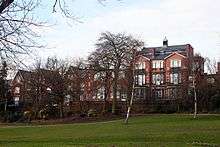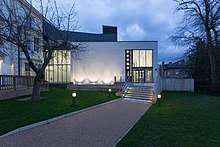Nottingham Girls' High School
| Established | 1875 |
|---|---|
| Type | Independent selective day school |
| Location |
Arboretum Street Nottingham Nottinghamshire NG1 4JB England 52°57′46″N 1°09′22″W / 52.9627°N 1.1562°WCoordinates: 52°57′46″N 1°09′22″W / 52.9627°N 1.1562°W |
| DfE URN | 122936 Tables |
| Students | 750 |
| Gender | Girls |
| Ages | 4–18 |
| Houses |
Bolton Hastings Luxton Skeel |
| Colours |
Sky Blue, Navy Blue |
| Website | www.nottinghamgirlshigh.gdst.net |
Nottingham Girls' High School is an independent selective day school for girls aged 4-18, situated just north of Nottingham city centre. The school was founded in 1875 and forms part of the Girls' Day School Trust.

History
Nottingham Girls' High School was founded on 14 September 1875 by the Girls' Public Day School Company (now the Girls' Day School Trust).[1] It was among the first such schools opened outside London.
Before the 1870s, education for girls in Nottingham was fixed by social class, with limited opportunities for working-class girls to receive any post-primary schooling. Much of the development in girls' education was due to the work of feminist reformers. Nottingham Girls' High School was originally on Oxford Street, with Mrs Bolton as Headmistress, before relocating to its current location on Arboretum Street, in a building formerly a lace manufacturer's house. When the school first opened, it had 34 pupils, but by the time of its relocation it had expanded to 146.
The outbreak of the Second World WAr in 1939 caused the school to move to two separate locations: Ramsdale Park and Daybrook. The Arboretum Street buildings accommodate the South Notts Hussars. However, by 1944–45 the school was able to move back. Just ten years later, as the school celebrated its 80th anniversary, the number of pupils reached 800.
The 1970s saw significant building expansion at the school and in 1975 the school marked its centenary. On 18 May 1973, the Milford Building was officially opened by HRH the Duchess of Gloucester and in 1978, HRH the Duke of Edinburgh opened the Edinburgh Library.
In 1995, the House system was introduced and named after the first four headmistresses of the school: Bolton, Hastings, Luxton and Skeel. The Bowering Sports Hall was opened by Richard Bacon in 1998 and eleven years later, in May 2009, the new Sixth Form Centre opened.
In 2016 when the Old Dining Hall building was demolished and replaced by a performing arts centre known as The Space and named The Squire Performing Arts Centre, after an alumna, Dame Rosemary Squire.
Over its history, the school has been overseen by 13 headmistresses and one acting headmistress. Today's Head is Julie Keller.
Facilities
Originally based in a group of Victorian houses, the school has since expanded considerably. The campus now boasts a state-of-the art performing arts centre called The Space located where the Old Dining Hall and Uniform Shop used to be. The Space is used for music and drama productions at the school and can also be hired by external bodies for conferences, meetings and performances. It is also a great source of education for those girls interested in all aspects of the performing arts and theatre production work, from music to lighting.

There is also a Sixth Form Centre adjoining The Space, with bright, modern classrooms, its own kitchen area and tuck shop, and outside garden and decking area. Sixth Form girls are encouraged to be independent. There are two libraries - one in the Senior School and one in the Junior School; a lecture theatre, drama studio, music building, a modern purpose-built dining hall, and common rooms for the lower and upper school. The Infant and Junior School are on the same site but based in the buildings on Balmoral Road.
In recent years, the school has invested in IT provision and training; for example, all girls from Year 4 upwards are issued with a personal iPad while the younger girls share iPad facilities. Classrooms are equipped with interactive whiteboards and there is digital equipment for use across all areas of the curriculum, such as cameras and microscopes. DT and food rooms have also been recently refurbished to include a 3D printer among other high tech equipment.
The school grounds include large all-weather courts, grass pitches, a gymnasium, sports hall and fitness suite. The outdoor learning area is a space comprising a climbing wall; Upnah Wood has plentiful outdoor learning equipment, such as low ropes, a fire pit and a pizza oven. There is an additional sports ground at Grassington Road in Aspley, due for substantial reinvestment and redevelopment in the future.
Houses
The four school houses are named after the four first headmistresses of the school; Bolton, Hastings, Luxton and Skeel. In recent years, the Junior School has also adopted the House system, so that girls can be in the same House as siblings further up the school. The House system is intended to build team spirit, for instance through inter-house competitions and sports events.
Academic structure
The school can accommodate around 900 girls aged from 4 to 18. The Sixth Form makes up nearly 30 per cent of the Senior School and is overseen by a Head of Sixth Form, Erin Skelton. There are usually around 280 girls in the Junior School, which has its own Head, currently Laura Fowler. The Head of whole school is Julie Keller. As one of the largest of the 23 schools and 2 academies run through the Girls' Day School Trust, Nottingham Girls' High School is part of an organisation which has promoted and specialised in the education of girls since its foundation in 1872.
Student executive
The Sixth Form elects a group of 16 girls, including a Head Girl and two Deputy Head Girls, who organise social events. There is also a senior prefect team to aid the Head Girl in her duties. Three House Captains are also appointed per House to run house events and participation.
Notable alumnae
- Gina Birch, bass player with The Raincoats
- Helen Cooper, literary scholar
- Helen Cresswell, children's author[2]
- Janice Elliott, novelist, journalist and children's writer
- Helen Karagounis, née Thieme, Olympic athlete
- Sudha Kheterpal, percussionist
- Clare Hammond, concert pianist
- Julie Myerson, author, and writer in the Financial Times
- Stella Rimington, former Director-General of MI5[3]
- Indhu Rubasingham, theatre director
- Molly Whittington-Egan, writer
- Rosemary Squire, theatre owner and entrepreneur
References
- ↑ Meller, Helen Elizabeth (1971). Nottingham in the eighteen eighties: a study in social change. University of Nottingham. p. 43.
- ↑ Carter, James (2002). Talking Books: Children's Authors Talk About the Craft, Creativity and Process of Writing, Volume 2. Routledge. pp. 114–29. ISBN 9780203025178.
- ↑ ""Notable GDST Alumnae", Annual Review 2011 – More than an education" (PDF). Girls' Day School Trust (courtesty of Times Educational Supplement).
External links
- School Website
- Profile on the ISC website
- Profile on the GDST website
- Profile at MyDaughter